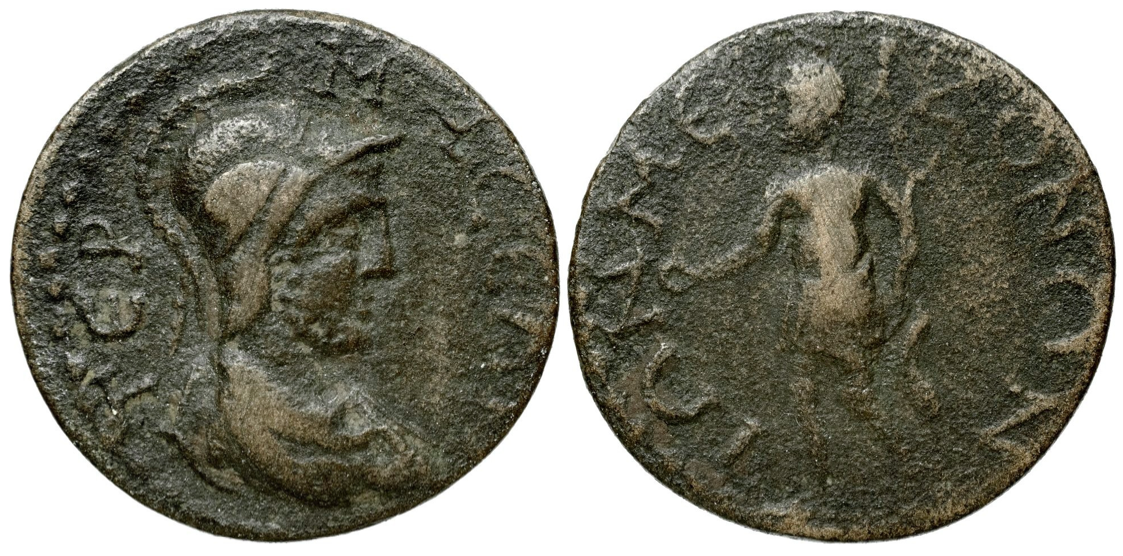RQEM ad. 465 - Termessus Major (Pisidia), bronze, middle 2nd-beginning 3rd century
From SILVER
150 - 225 bronze 0 kg
Description
| ObverseInscription or printing placed on the obverse.: | Several legends: 1) TEPMHCCEΩN ; 2) TEPMHCEΩN (Greek).Several types: 1) Head or bust of the hero Solymus right, (bearded and) wearing a crested Corinthian helmet, 2) Head of Zeus right, wearing a laurel wreath. |
| ReverseInscription or printing placed on the reverse.: | Several legends : 1) TΩN MEIZONΩN ; 2) COΛΥMOC ; 3) AYTONOMΩN (Greek).Several types: 1) Solymos left, wearing a helmet, holding a spear and a sword, 2) Hermes three quarter facing left, wearing a chiton, holding a patera and a caduceus. Border of dots, 3) Solymos seated left, 4) Temple distyle, 5) Tyche left, holding a cornucopia and a rudder, 6) Nike left, holding a palm and a wreath, 7) Female charakter right, 7) Male charakter (Termessus?) left, holding a patera. |
Mint and issuing power
| MintIdentifies the place of manufacture or issue of a numismatic object.: | Termessos Major | Ancient regionAncient region.: | Modern countryModern country: | AuthorityIdentifies the issuing power. The authority can be "pretended" when the name or the portrait of X is on the coin but he/she was not the issuing power. It can also be "uncertain" when there is no mention of X on the coin but he/she was the issuing power according to the historical sources: |
Chronology
| FromIdentifies the initial date in a range assigned in a numismatic context. | 150 | toIdentifies the final date in a range assigned in a numismatic context.. | 225 | PeriodTime period of the numismatic object.: Roman from 30 BC |
Physical description
| MetalThe physical material (usually metal) from which an object is made.: | bronze"bronze" is not in the list (Bronze, Silver, Gold, Lead, Aluminum, Iron, Copper, Steel, Brass, Zinc, ...) of allowed values for the "Metal" property. | DenominationTerm indicating the value of a numismatic object. Examples: tetradrachm, chalkous, denarius.: | StandardStandard.: | ||
| Range of weightsRange of the actual weights of a numismatic object (in grams).: | 3.32-12.23 |
Image

RQEM_ad_465.png "Paris, BnF, Fonds général 919 (https" has not been listed as valid URI scheme.[Paris, BnF, Fonds général 919 (https://gallica.bnf.fr/ark:/12148/btv1b85164670)]
References
| Die study referencePublication of the study: | Kosmotatou 19971Kosmotatou 1997, p. 42-44 (group 1) | ||
| Coin series referenceReference to coin series study: | |||
Obverse dies distribution
| FrequencyFrequency of specimen in distribution. ᵖ | Number of obversesNumber of obverse dies. ᵖ (o) | % (o) | Number of coinsNumber of coins. (n) | % (n) | Die nameName(s) of the die(s). |
| 1 | 7 | 41.18 | 7 | 13.46 | O1, O8, O9, O12, O15, O16, O17 |
| 2 | 5 | 29.41 | 10 | 19.23 | O2, O4, O6, O11, O14 |
| 3 | 1 | 5.88 | 3 | 5.77 | O5 |
| 5 | 1 | 5.88 | 5 | 9.62 | O3 |
| 7 | 2 | 11.76 | 14 | 26.92 | O10, O13 |
| 13 | 1 | 5.88 | 13 | 25 | O7 |
| Total | 17 of 17 | 99.99 | 52 of 52 | 100 |
Reverse dies distribution
no distribution is available
Quantification
| Number of obversesNumber of obverse dies. ᵖ (o) | 17 | Number of singletons (o1)The number of singleton coins. ᵖ | 7 |
| Number of reverse diesNumber of reverse dies. (r) | 28 | Number of coinsNumber of coins. (n) | 52 |
| Coins per obverse dieNumber of coins per obverse die. (n/o) | 3.06 | Coins per reverse dieNumber of coins per reverse die. (n/r) | 1.86 |
| Reverse per obverse ratioRatio of obverse dies divided by reverse dies. (r/o) | 1.65 | Percentage of singletons (o1)number of coins (n) divided by the number of singletons (o1) ᵖ | 41.18 % |
| Original number of dies (O) (Carter 1983 formula)The estimation of the number of coins according to Carter 1983 ᵖ | 21.43 | Coins struck if 20,000 as average productivity per dieCoins made if the average productivity for obverses (according to Carter) is 20,000. ᵖ | 428,600 |
| Original number of dies (O) (Esty 2011 formula)The estimation of the number of coins according to the singleton formula in Esty 2011 ᵖ (O) | 25.26 | Survival rate if 20,000 as average productivity per dieSurvival rate if average productivity is 20,000. ᵖ | 0.00012 |
| Coverage (o = % of O) (Esty 1984 formula)Esty 1984 - coverage (% of O) ᵖ (o = % of O) | 86.54% | Die productivity if survival rate 1/2,000Average productivity if survival rate is 1/2,000. ᵖ | 4,853.01 |
| Weight of silver (in kg) if 20,000 coins per die (O = Carter formula)Carter 1983 * Median weight * 20000 (*10 if gold or electrum) ᵖ | 0 kg <br /> 0 kg | Die productivity if survival rate 1/5,000Average productivity if survival rate is 1/5,000. ᵖ | 12,132.52 |
Remarks
References
- ^ Kosmotatou 1997